2023 HYUNDAI SANTA CRUZ trailer
[x] Cancel search: trailerPage 275 of 598
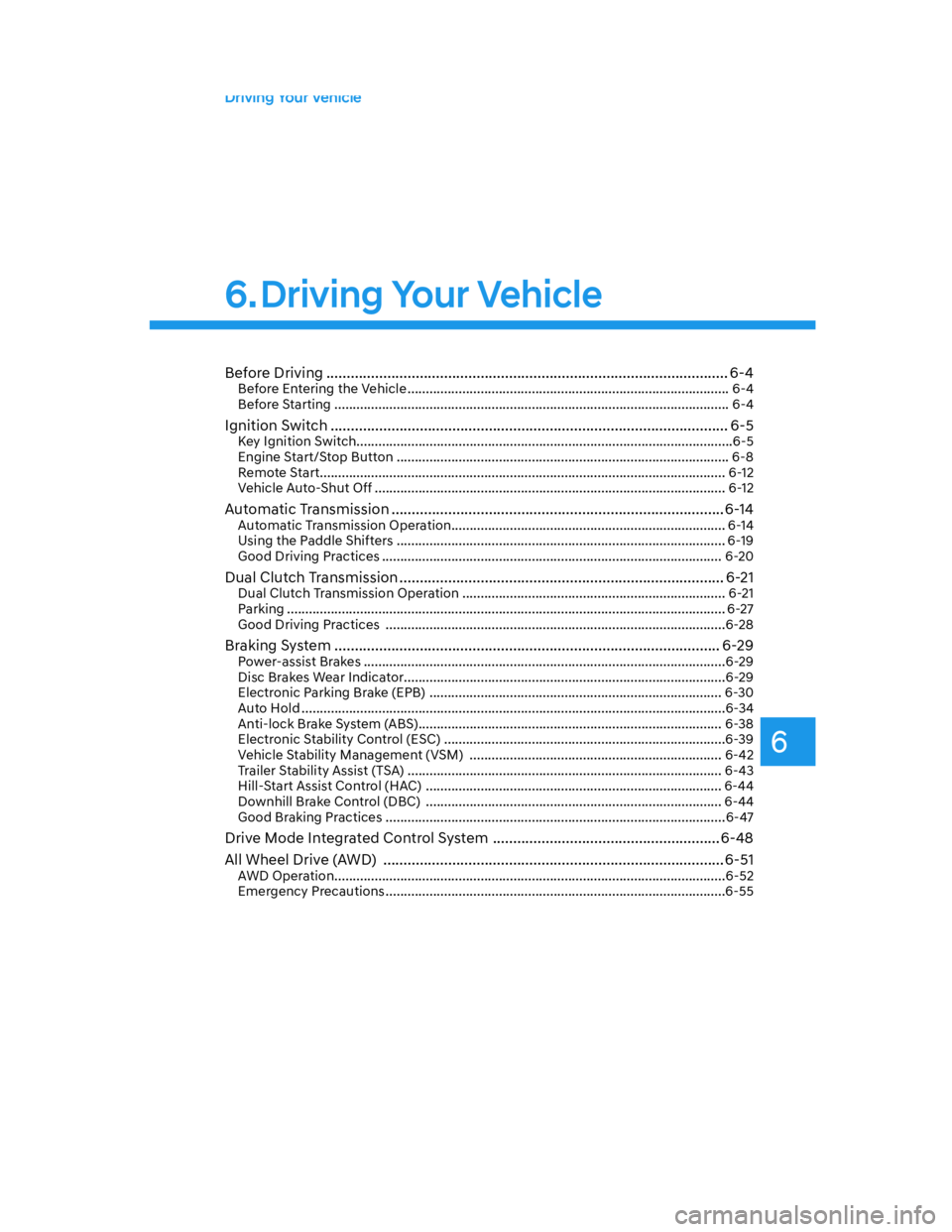
6
Before Driving ................................................................................................... 6-4Before Entering the Vehicle ........................................................................................ 6-4
Before Starting ............................................................................................................ 6-4
Ignition Switch .................................................................................................. 6-5
Key Ignition Switch .......................................................................................................6-5
Engine Start/Stop Button ........................................................................................... 6-8
Remote Start ............................................................................................................... 6-12
Vehicle Auto-Shut Off ................................................................................................ 6-12
Automatic Transmission ..................................................................................6-14
Automatic Transmission Operation ........................................................................... 6-14
Using the Paddle Shifters .......................................................................................... 6-19
Good Driving Practices ............................................................................................. 6-20
Dual Clutch Transmission ................................................................................ 6-21
Dual Clutch Transmission Operation ........................................................................ 6-21
Parking ........................................................................................................................6-27
Good Driving Practices .............................................................................................6-28
Braking System ............................................................................................... 6-29Power-assist Brakes ...................................................................................................6-29
Disc Brakes Wear Indicator........................................................................................6-29
Electronic Parking Brake (EPB) ................................................................................ 6-30
Auto Hold ....................................................................................................................6-34
Anti-lock Brake System (ABS) ................................................................................... 6-38
Electronic Stability Control (ESC) .............................................................................6-39
Vehicle Stability Management (VSM) ..................................................................... 6-42
Trailer Stability Assist (TSA) ...................................................................................... 6-43
Hill-Start Assist Control (HAC) ................................................................................. 6-44
Downhill Brake Control (DBC) ................................................................................. 6-44
Good Braking Practices .............................................................................................6-47
Drive Mode Integrated Control System ........................................................6-48
All Wheel Drive (AWD) ....................................................................................6-51
AWD Operation ...........................................................................................................6-52
Emergency Precautions .............................................................................................6-55
6. Driving Your Vehicle
Driving Your Vehicle
Page 276 of 598
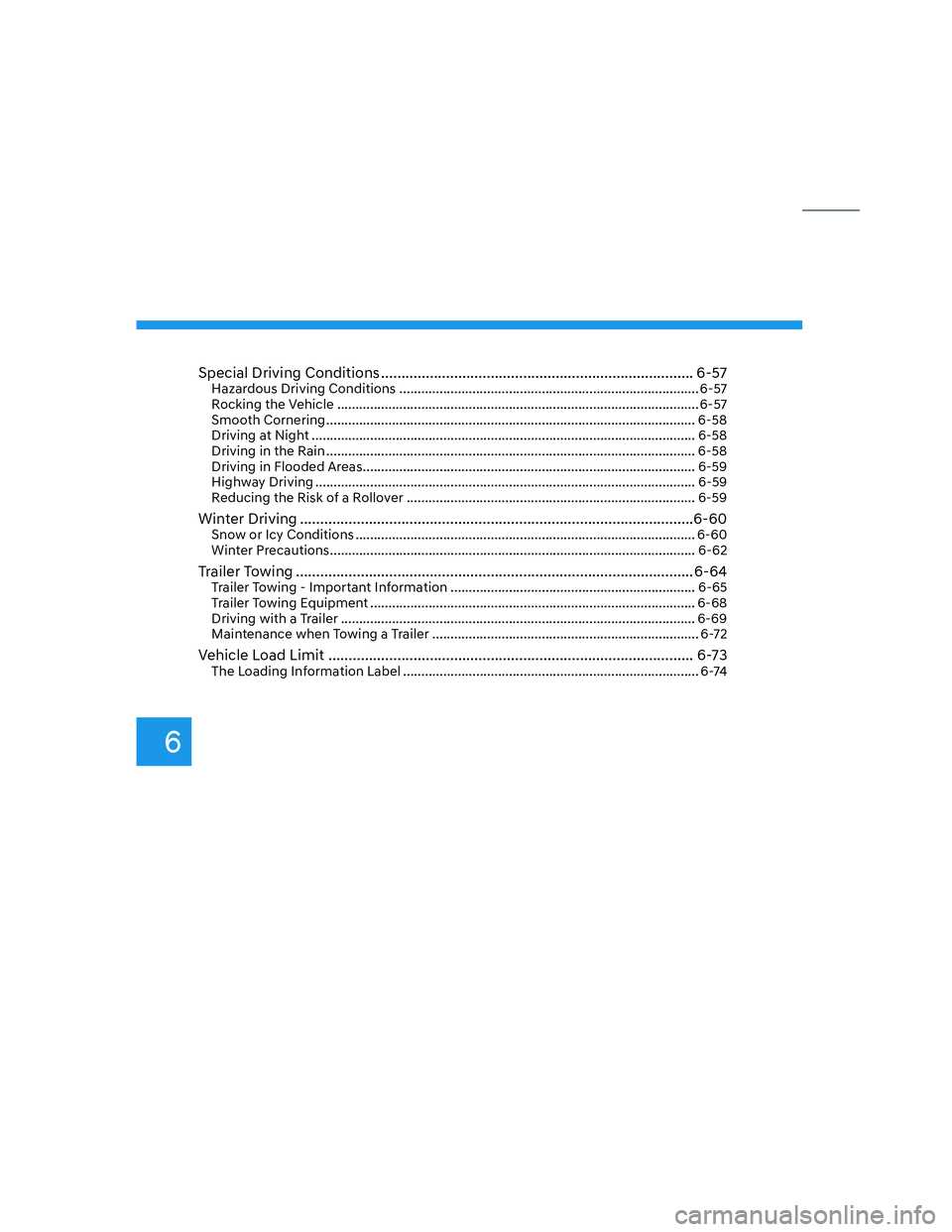
6
Special Driving Conditions ............................................................................. 6-57Hazardous Driving Conditions .................................................................................. 6-57
Rocking the Vehicle ................................................................................................... 6-57
Smooth Cornering ..................................................................................................... 6-58
Driving at Night ......................................................................................................... 6-58
Driving in the Rain ..................................................................................................... 6-58
Driving in Flooded Areas ........................................................................................... 6-59
Highway Driving ........................................................................................................ 6-59
Reducing the Risk of a Rollover ............................................................................... 6-59
Winter Driving .................................................................................................6-60Snow or Icy Conditions ............................................................................................. 6-60
Winter Precautions .................................................................................................... 6-62
Trailer Towing ..................................................................................................6-64
Trailer Towing - Important Information ................................................................... 6-65
Trailer Towing Equipment ......................................................................................... 6-68
Driving with a Trailer ................................................................................................. 6-69
Maintenance when Towing a Trailer ......................................................................... 6-72
Vehicle Load Limit .......................................................................................... 6-73
The Loading Information Label ................................................................................. 6-74
Page 317 of 598
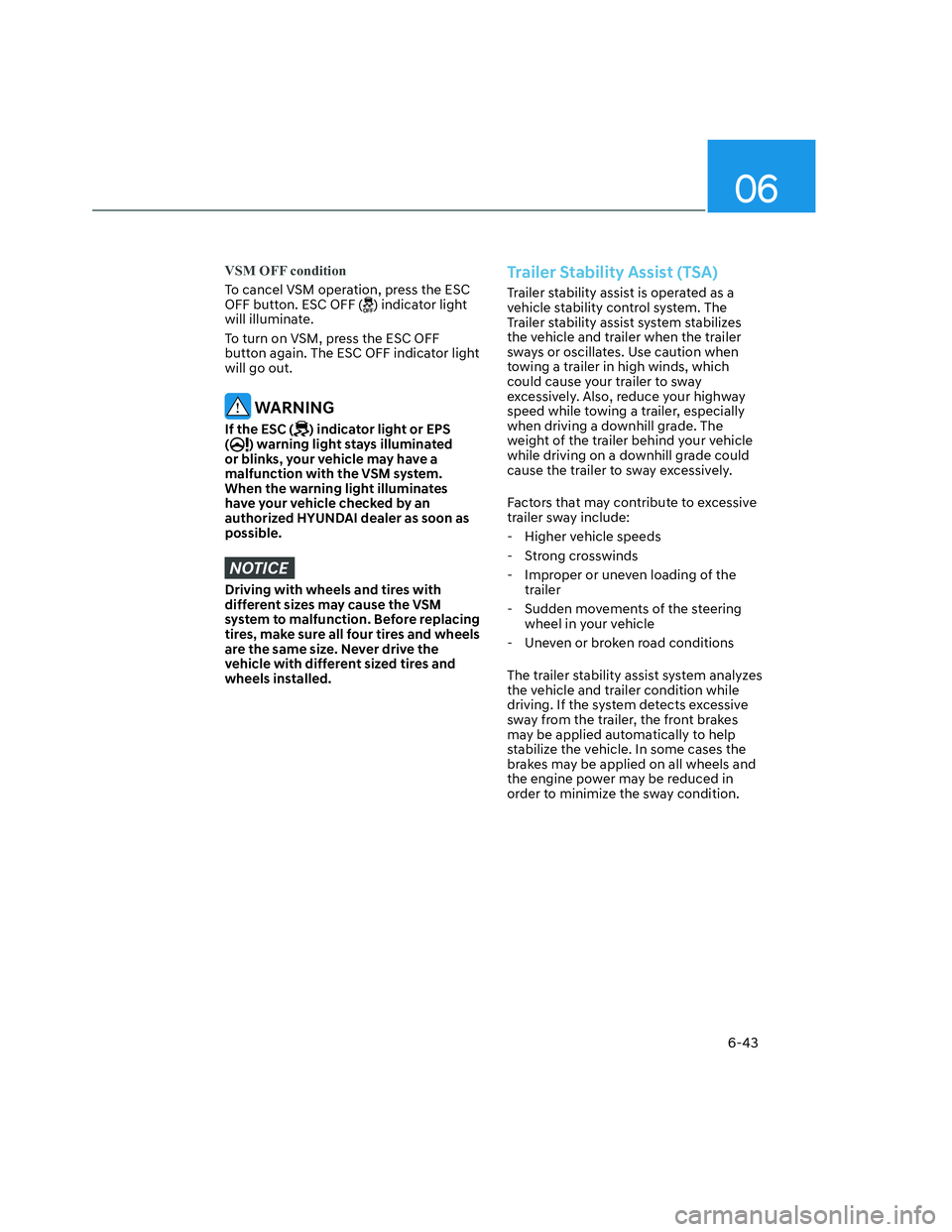
06
6-43
VSM OFF condition
To cancel VSM operation, press the ESC
OFF button. ESC OFF () indicator light
will illuminate.
To turn on VSM, press the ESC OFF
button again. The ESC OFF indicator light
will go out.
WARNING
If the ESC () indicator light or EPS
() warning light stays illuminated
or blinks, your vehicle may have a
malfunction with the VSM system.
When the warning light illuminates
have your vehicle checked by an
authorized HYUNDAI dealer as soon as
possible.
NOTICE
Driving with wheels and tires with
different sizes may cause the VSM
system to malfunction. Before replacing
tires, make sure all four tires and wheels
are the same size. Never drive the
vehicle with different sized tires and
wheels installed.
Trailer Stability Assist (TSA)
Trailer stability assist is operated as a
vehicle stability control system. The
Trailer stability assist system stabilizes
the vehicle and trailer when the trailer
sways or oscillates. Use caution when
towing a trailer in high winds, which
could cause your trailer to sway
excessively. Also, reduce your highway
speed while towing a trailer, especially
when driving a downhill grade. The
weight of the trailer behind your vehicle
while driving on a downhill grade could
cause the trailer to sway excessively.
Factors that may contribute to excessive
trailer sway include:
- Higher vehicle speeds
- Strong crosswinds
- Improper or uneven loading of the
trailer
- Sudden movements of the steering
wheel in your vehicle
- Uneven or broken road conditions
The trailer stability assist system analyzes
the vehicle and trailer condition while
driving. If the system detects excessive
sway from the trailer, the front brakes
may be applied automatically to help
stabilize the vehicle. In some cases the
brakes may be applied on all wheels and
the engine power may be reduced in
order to minimize the sway condition.
Page 338 of 598
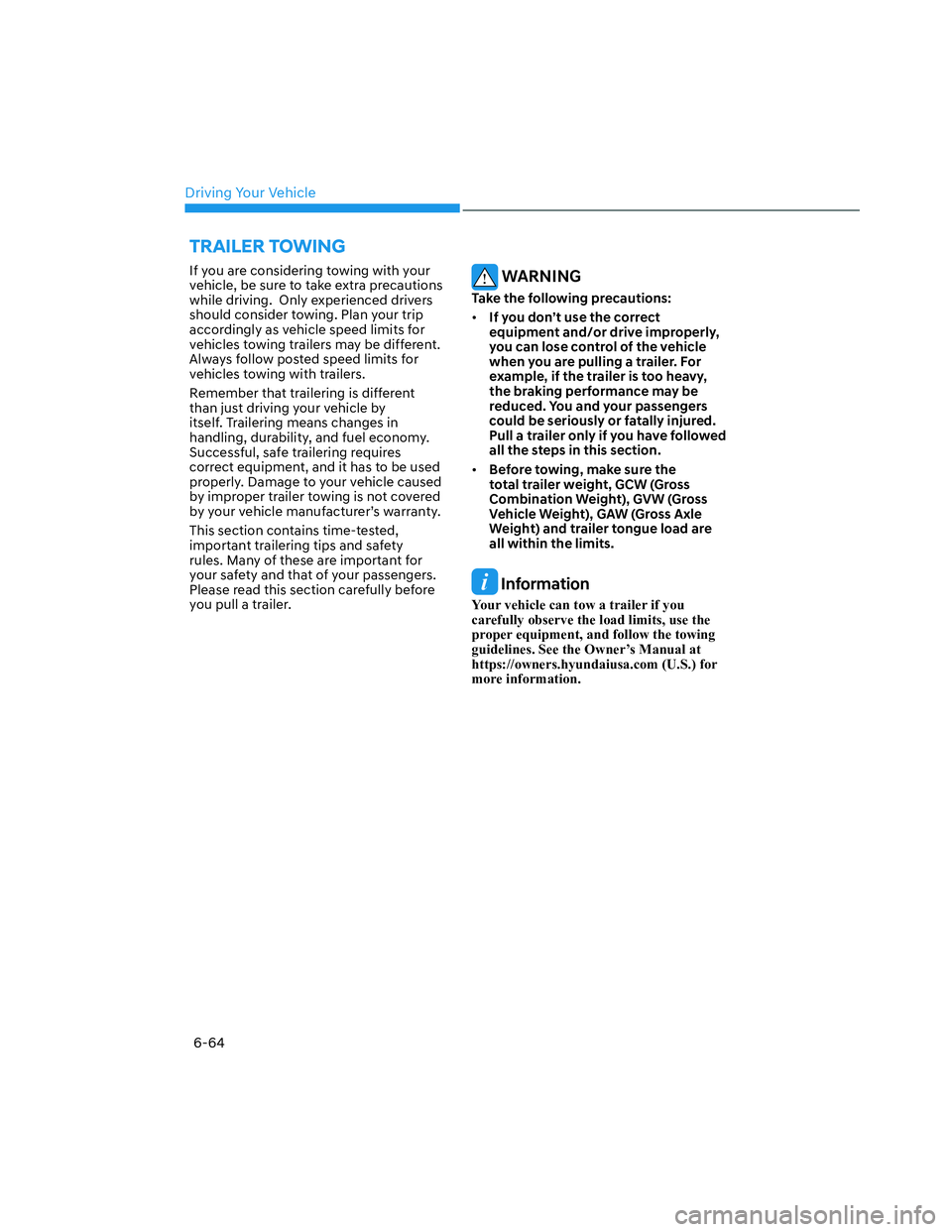
Driving Your Vehicle
6-64
If you are considering towing with your
vehicle, be sure to take extra precautions
while driving. Only experienced drivers
should consider towing. Plan your trip
accordingly as vehicle speed limits for
vehicles towing trailers may be different.
Always follow posted speed limits for
vehicles towing with trailers.
Remember that trailering is different
than just driving your vehicle by
itself. Trailering means changes in
handling, durability, and fuel economy.
Successful, safe trailering requires
correct equipment, and it has to be used
properly. Damage to your vehicle caused
by improper trailer towing is not covered
by your vehicle manufacturer’s warranty.
This section contains time-tested,
important trailering tips and safety
rules. Many of these are important for
your safety and that of your passengers.
Please read this section carefully before
you pull a trailer. WARNING
Take the following precautions:
• If you don’t use the correct
equipment and/or drive improperly,
you can lose control of the vehicle
when you are pulling a trailer. For
example, if the trailer is too heavy,
the braking performance may be
reduced. You and your passengers
could be seriously or fatally injured.
Pull a trailer only if you have followed
all the steps in this section.
• Before towing, make sure the
total trailer weight, GCW (Gross
Combination Weight), GVW (Gross
Vehicle Weight), GAW (Gross Axle
Weight) and trailer tongue load are
all within the limits.
Information
Your vehicle can tow a trailer if you
carefully observe the load limits, use the
proper equipment, and follow the towing
guidelines. See the Owner’s Manual at
https://owners.hyundaiusa.com (U.S.) for
more information.
TRAILER TOWING
Page 339 of 598
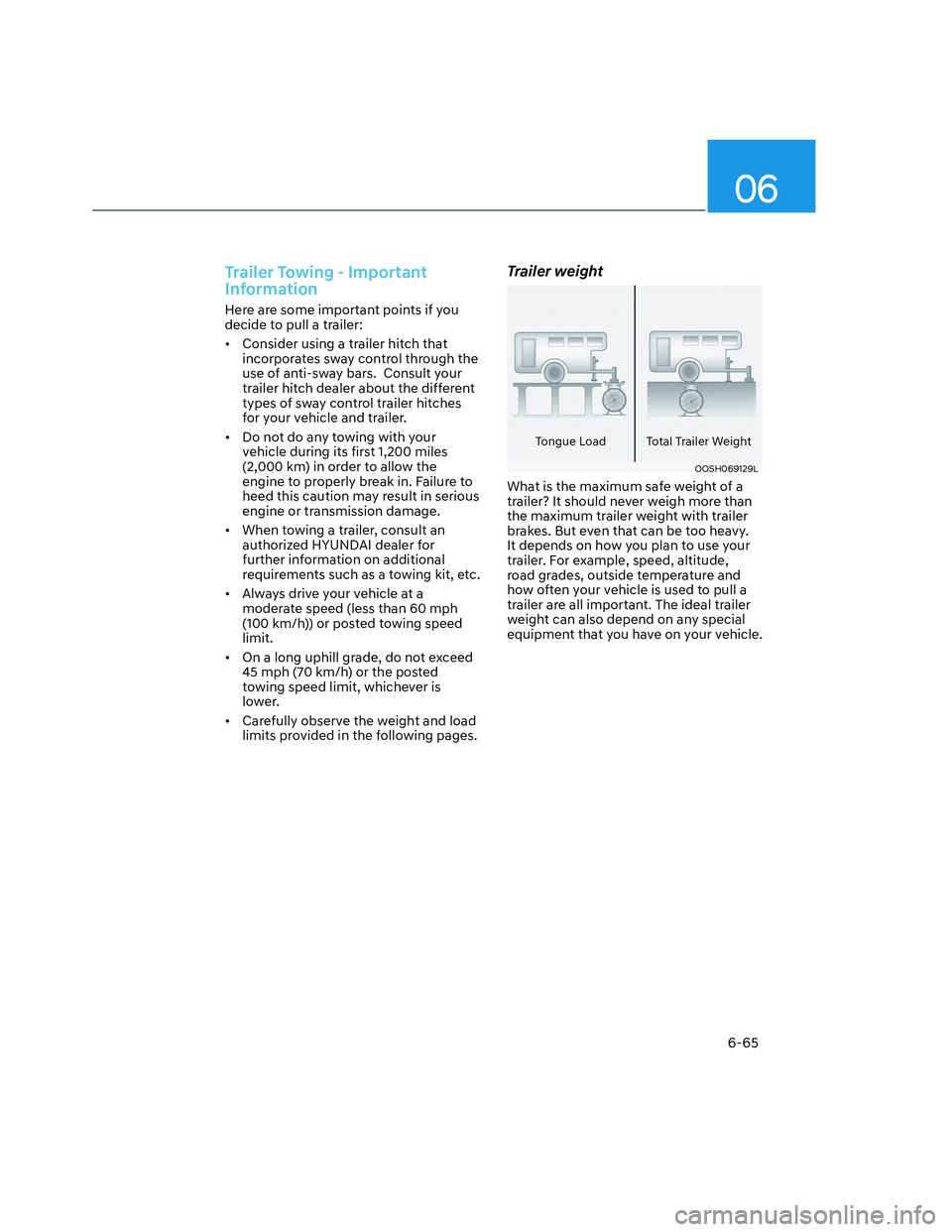
06
6-65
Trailer Towing - Important
Information
Here are some important points if you
decide to pull a trailer:
• Consider using a trailer hitch that
incorporates sway control through the
use of anti-sway bars. Consult your
trailer hitch dealer about the different
types of sway control trailer hitches
for your vehicle and trailer.
• Do not do any towing with your
vehicle during its first 1,200 miles
(2,000 km) in order to allow the
engine to properly break in. Failure to
heed this caution may result in serious
engine or transmission damage.
• When towing a trailer, consult an
authorized HYUNDAI dealer for
further information on additional
requirements such as a towing kit, etc.
• Always drive your vehicle at a
moderate speed (less than 60 mph
(100 km/h)) or posted towing speed
limit.
• On a long uphill grade, do not exceed
45 mph (70 km/h) or the posted
towing speed limit, whichever is
lower.
• Carefully observe the weight and load
limits provided in the following pages.
Trailer weight
Tongue Load Total Trailer Weight
OOSH069129LOOSH069129L
What is the maximum safe weight of a
trailer? It should never weigh more than
the maximum trailer weight with trailer
brakes. But even that can be too heavy.
It depends on how you plan to use your
trailer. For example, speed, altitude,
road grades, outside temperature and
how often your vehicle is used to pull a
trailer are all important. The ideal trailer
weight can also depend on any special
equipment that you have on your vehicle.
Page 340 of 598
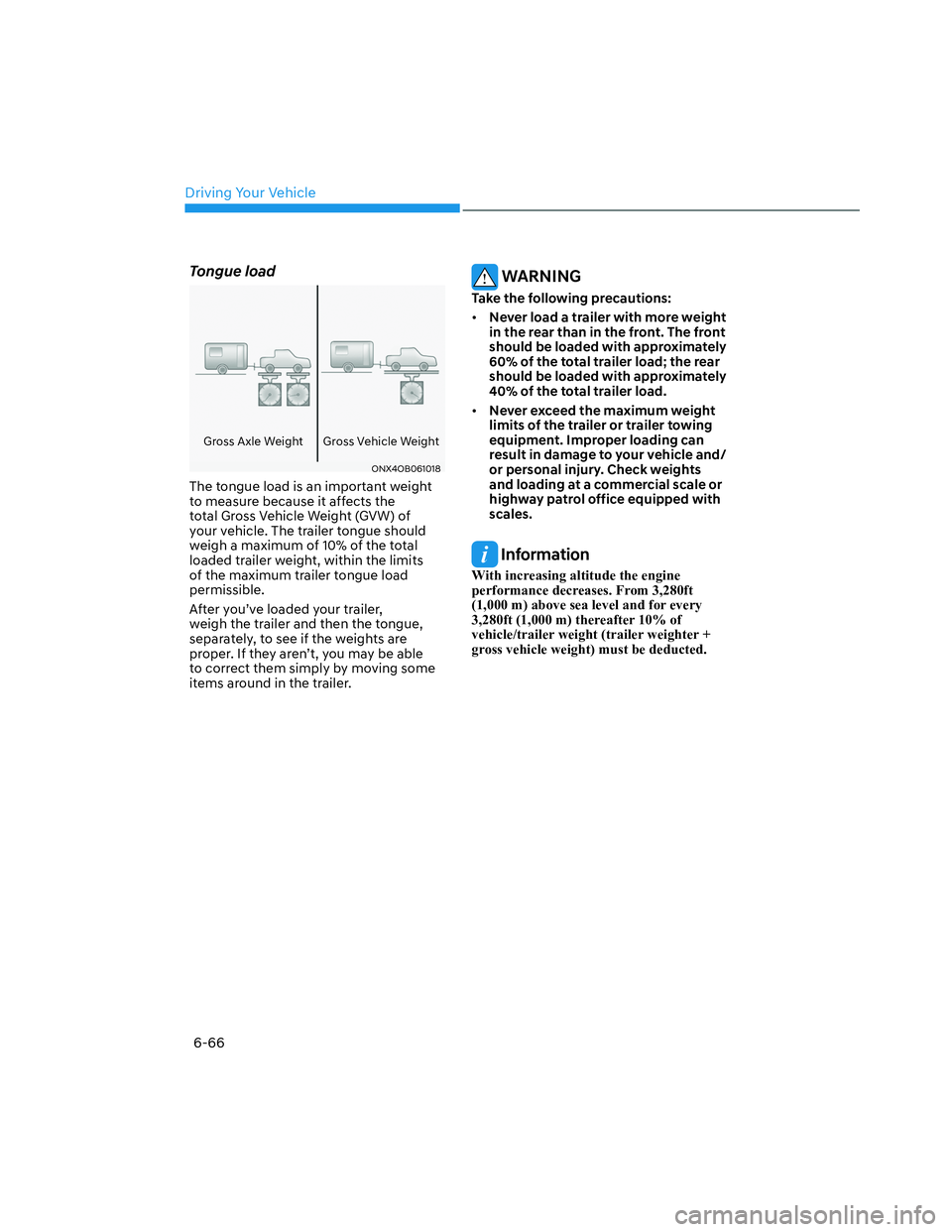
Driving Your Vehicle
6-66
Tongue load
Gross Axle Weight Gross Vehicle Weight
ONX4OB061018ONX4OB061018
The tongue load is an important weight
to measure because it affects the
total Gross Vehicle Weight (GVW) of
your vehicle. The trailer tongue should
weigh a maximum of 10% of the total
loaded trailer weight, within the limits
of the maximum trailer tongue load
permissible.
After you’ve loaded your trailer,
weigh the trailer and then the tongue,
separately, to see if the weights are
proper. If they aren’t, you may be able
to correct them simply by moving some
items around in the trailer.
WARNING
Take the following precautions:
• Never load a trailer with more weight
in the rear than in the front. The front
should be loaded with approximately
60% of the total trailer load; the rear
should be loaded with approximately
40% of the total trailer load.
• Never exceed the maximum weight
limits of the trailer or trailer towing
equipment. Improper loading can
result in damage to your vehicle and/
or personal injury. Check weights
and loading at a commercial scale or
highway patrol office equipped with
scales.
Information
With increasing altitude the engine
performance decreases. From 3,280ft
(1,000 m) above sea level and for every
3,280ft (1,000 m) thereafter 10% of
vehicle/trailer weight (trailer weighter +
gross vehicle weight) must be deducted.
Page 341 of 598
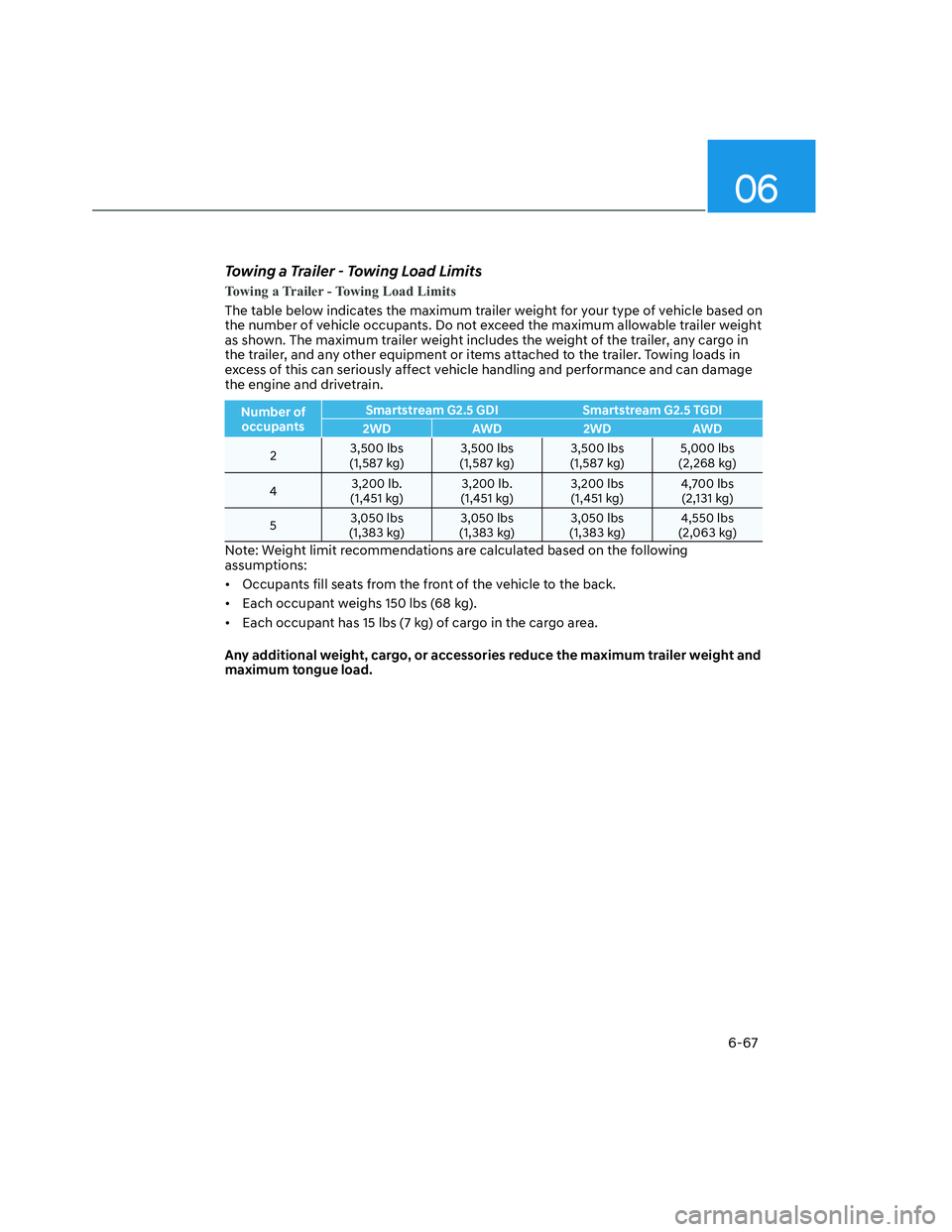
06
6-67
Towing a Trailer - Towing Load Limits
Towing a Trailer - Towing Load Limits
The table below indicates the maximum trailer weight for your type of vehicle based on
the number of vehicle occupants. Do not exceed the maximum allowable trailer weight
as shown. The maximum trailer weight includes the weight of the trailer, any cargo in
the trailer, and any other equipment or items attached to the trailer. Towing loads in
excess of this can seriously affect vehicle handling and performance and can damage
the engine and drivetrain.
Number of
occupantsSmartstream G2.5 GDI Smartstream G2.5 TGDI
2WD AWD 2WD AWD
23,500 lbs
(1,587 kg)3,500 lbs
(1,587 kg)3,500 lbs
(1,587 kg)5,000 lbs
(2,268 kg)
43,200 lb.
(1,451 kg)3,200 lb.
(1,451 kg)3,200 lbs
(1,451 kg)4,700 lbs
(2,131 kg)
53,050 lbs
(1,383 kg)3,050 lbs
(1,383 kg)3,050 lbs
(1,383 kg)4,550 lbs
(2,063 kg)
Note: Weight limit recommendations are calculated based on the following
assumptions:
• Occupants fill seats from the front of the vehicle to the back.
• Each occupant weighs 150 lbs (68 kg).
• Each occupant has 15 lbs (7 kg) of cargo in the cargo area.
Any additional weight, cargo, or accessories reduce the maximum trailer weight and
maximum tongue load.
Page 342 of 598
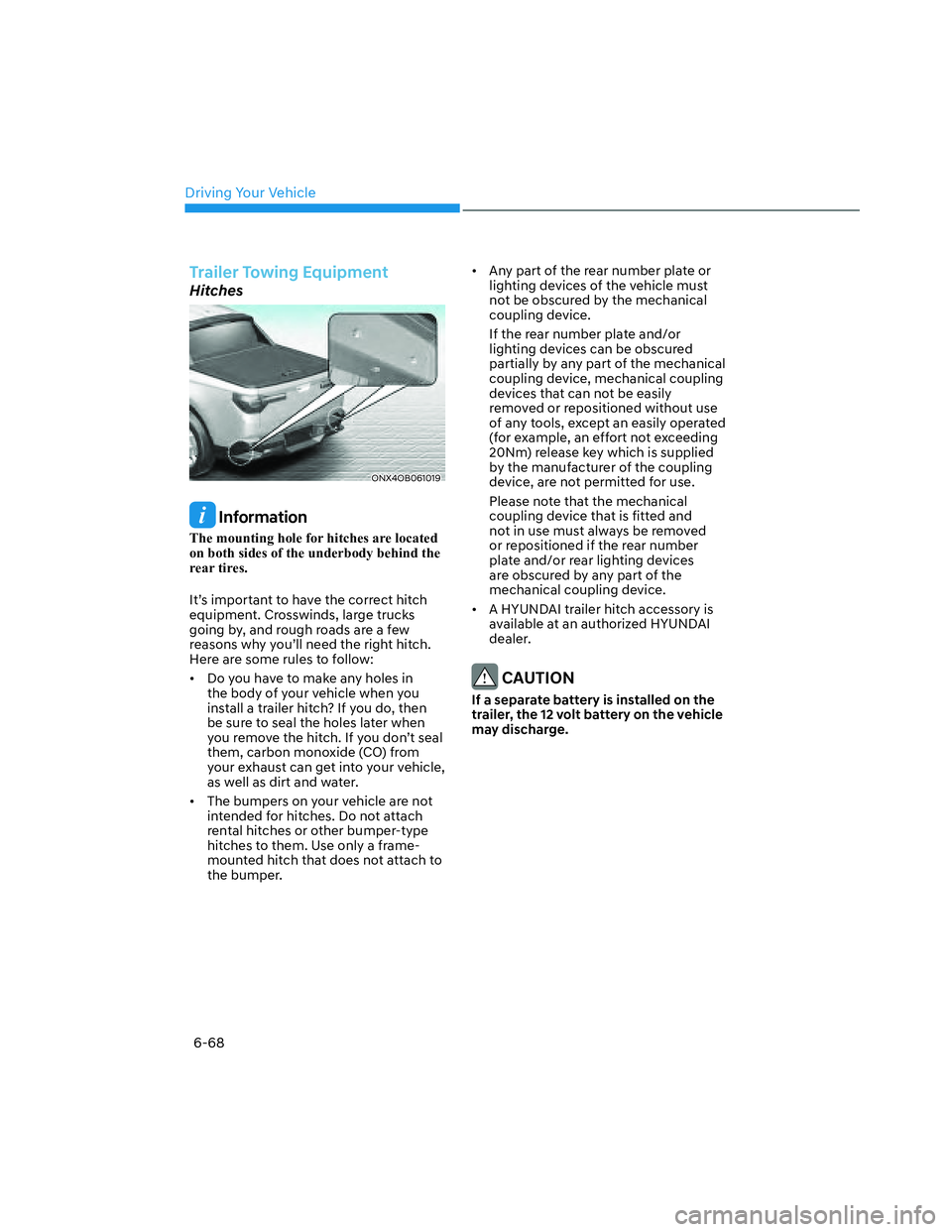
Driving Your Vehicle
6-68
Trailer Towing Equipment
Hitches
ONX4OB061019ONX4OB061019
Information
The mounting hole for hitches are located
on both sides of the underbody behind the
rear tires.
It’s important to have the correct hitch
equipment. Crosswinds, large trucks
going by, and rough roads are a few
reasons why you’ll need the right hitch.
Here are some rules to follow:
• Do you have to make any holes in
the body of your vehicle when you
install a trailer hitch? If you do, then
be sure to seal the holes later when
you remove the hitch. If you don’t seal
them, carbon monoxide (CO) from
your exhaust can get into your vehicle,
as well as dirt and water.
• The bumpers on your vehicle are not
intended for hitches. Do not attach
rental hitches or other bumper-type
hitches to them. Use only a frame-
mounted hitch that does not attach to
the bumper.• Any part of the rear number plate or
lighting devices of the vehicle must
not be obscured by the mechanical
coupling device.
If the rear number plate and/or
lighting devices can be obscured
partially by any part of the mechanical
coupling device, mechanical coupling
devices that can not be easily
removed or repositioned without use
of any tools, except an easily operated
(for example, an effort not exceeding
20Nm) release key which is supplied
by the manufacturer of the coupling
device, are not permitted for use.
Please note that the mechanical
coupling device that is fitted and
not in use must always be removed
or repositioned if the rear number
plate and/or rear lighting devices
are obscured by any part of the
mechanical coupling device.
• A HYUNDAI trailer hitch accessory is
available at an authorized HYUNDAI
dealer.
CAUTION
If a separate battery is installed on the
trailer, the 12 volt battery on the vehicle
may discharge.